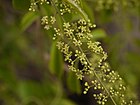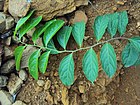Note: This is a project under development. The articles on this wiki are just being initiated and broadly incomplete. You can Help creating new pages.
Difference between revisions of "Celastrus paniculatus - Jyotishmati"
(→List of Ayurvedic medicine in which the herb is used) |
|||
| (13 intermediate revisions by the same user not shown) | |||
| Line 2: | Line 2: | ||
'''Jyotishmati''' is a deciduous, climbing shrub. The stems twine into the surrounding vegetation, helping to support themselves by means of hooked prickles. The plant is harvested from the wild for local use as a medicine and source of oil. | '''Jyotishmati''' is a deciduous, climbing shrub. The stems twine into the surrounding vegetation, helping to support themselves by means of hooked prickles. The plant is harvested from the wild for local use as a medicine and source of oil. | ||
==Uses== | ==Uses== | ||
| − | {{Uses|Memory loss}}, {{Uses|Rheumatic arthritis}}, {{Uses|Insomnia}}, {{Uses|Opium poisoning}}, {{Uses|Impotence}} | + | {{Uses|Memory loss}}, {{Uses|Rheumatic arthritis}}, {{Uses|Insomnia}}, {{Uses|Opium poisoning}}, {{Uses|Impotence}}, {{Uses|Piles}}, {{Uses|Wounds}}, {{Uses|Cough}}, {{Uses|Asthma}}, {{Uses|Stomachache}}, {{Uses|Indigestion}}, {{Uses|Constipation}}<ref name="Uses"/> |
| − | <ref name=" | + | |
| + | ===Food=== | ||
| + | Jyotishmati can be used in food. Unripe fruits are boiled and eaten as vegetable<ref name="Forest foods of Western Ghat"/>. | ||
==Parts Used== | ==Parts Used== | ||
| − | {{Parts Used| | + | {{Parts Used|Seed}}, {{Parts Used|Leaf}}, {{Parts Used|Root}}<ref name="Karnataka Medicinal Plants"/>. |
| + | |||
==Chemical Composition== | ==Chemical Composition== | ||
The seeds are reported to contain the alkaloids, celastrine and paniculatine, which are the active principles of the drug. <ref name="Chemical composition"/> | The seeds are reported to contain the alkaloids, celastrine and paniculatine, which are the active principles of the drug. <ref name="Chemical composition"/> | ||
==Common names== | ==Common names== | ||
| − | {{Common names|kn=Bhavanga beeja, Gangunde kaayi, Gangunga hambu, Maala kanguni|ml=Ceruppunna, Palulavam, Paluzhavam|sa=Agnibhasa, Jyotishlata, Jyotishmati, Supingala, Swarna lata|ta=Carasvati, Acuvalakkal, Malgangunicinnavaluluvai|te=Baavanji, Gandumida, |hi=Malakanguni, Mlkauni|en=Black oil plant}} | + | {{Common names|kn=Bhavanga beeja, Gangunde kaayi, Gangunga hambu, Maala kanguni|ml=Ceruppunna, Palulavam, Paluzhavam|sa=Agnibhasa, Jyotishlata, Jyotishmati, Supingala, Swarna lata|ta=Carasvati, Acuvalakkal, Malgangunicinnavaluluvai|te=Baavanji, Gandumida, |hi=Malakanguni, Mlkauni|en=Black oil plant}}<ref name="Common names"/> |
| − | <ref name="Common names"/> | ||
==Properties== | ==Properties== | ||
| Line 29: | Line 31: | ||
Vata, Kapha | Vata, Kapha | ||
===Prabhava=== | ===Prabhava=== | ||
| + | ===Nutritional components=== | ||
| + | Jyotishmaticontains the Following nutritional components likeVitamin-C; Calcium, Iron, Magnesium, Maganese, Potassium, Phosphorus, Sodium, Zinc<ref name="Forest foods of Western Ghat"/> | ||
==Habit== | ==Habit== | ||
| Line 38: | Line 42: | ||
===Flower=== | ===Flower=== | ||
| − | {{Flower|Bisexual|Terminal and axillary panicles|Yellowish white|5|Panicle to 15 x 8 cm, terminal, axillary, oblong; pedicel 6 mm long; flowers many | + | {{Flower|Bisexual|Terminal and axillary panicles|Yellowish white|5|Panicle to 15 x 8 cm, terminal, axillary, oblong; pedicel 6 mm long; flowers many. Flowering from February to May}} |
===Fruit=== | ===Fruit=== | ||
| − | {{Fruit|A capsule|| | + | {{Fruit|A capsule|1cm|Loculicidal, yellow|Seeds 3, aril reddish|Fruiting from February to May}} |
===Other features=== | ===Other features=== | ||
==List of Ayurvedic medicine in which the herb is used== | ==List of Ayurvedic medicine in which the herb is used== | ||
| − | + | [[Abana]], [[Kusum Keshavardhini Taila]], [[Jariforte]], [[Jyotishmatyadi Taila]]<ref name="Ayurvedic properties"/> | |
| − | |||
| − | <ref name="Ayurvedic properties"/> | ||
==Where to get the saplings== | ==Where to get the saplings== | ||
| Line 54: | Line 56: | ||
{{Propagation|Seeds}}, {{Propagation|Cuttings}}. | {{Propagation|Seeds}}, {{Propagation|Cuttings}}. | ||
| − | == | + | ==Cultivation Details== |
| − | + | Jyotishmati is available through september to December. Celastrus paniculatus can be grown from the warm temperate zone through to the tropics, it tolerates temperatures down to between -5 and -10°c. The plant fruits best when its roots are in the shade but its top growth can grow into a sunny position. It prefers a deep loamy soil. A gross feeder, it requires a rich soil. A rampant climber, it requires ample space and is best grown into an old tree.<ref name="Forest foods of Western Ghat"/> | |
| − | |||
| − | |||
| − | |||
| − | |||
| − | |||
| − | |||
| − | |||
==Commonly seen growing in areas== | ==Commonly seen growing in areas== | ||
| − | {{Commonly seen|Tropical area}}. | + | {{Commonly seen|Tropical area}}, {{Commonly seen|Semi-evergreen forest}}, {{Commonly seen|Moist deciduous forest}}. |
==Photo Gallery== | ==Photo Gallery== | ||
| Line 74: | Line 69: | ||
File:Celastrus paniculatus 15.JPG | File:Celastrus paniculatus 15.JPG | ||
File:Celastrus paniculatus 03.JPG | File:Celastrus paniculatus 03.JPG | ||
| − | |||
| − | |||
| − | |||
</gallery> | </gallery> | ||
==References== | ==References== | ||
| − | |||
<references> | <references> | ||
<ref name="Uses">[https://www.ayurtimes.com/celastrus-paniculatus-jyotishmati-malkangani/ Uses]</ref> | <ref name="Uses">[https://www.ayurtimes.com/celastrus-paniculatus-jyotishmati-malkangani/ Uses]</ref> | ||
<ref name="Chemical composition">[http://gbpihedenvis.nic.in/PDFs/Glossary_Medicinal_Plants_Springer.pdf Chemical composition]</ref> | <ref name="Chemical composition">[http://gbpihedenvis.nic.in/PDFs/Glossary_Medicinal_Plants_Springer.pdf Chemical composition]</ref> | ||
| − | |||
<ref name="Leaf">Kappatagudda - A Repertoire of Medicianal Plants of Gadag by Yashpal Kshirasagar and Sonal Vrishni, Page No. 119</ref> | <ref name="Leaf">Kappatagudda - A Repertoire of Medicianal Plants of Gadag by Yashpal Kshirasagar and Sonal Vrishni, Page No. 119</ref> | ||
<ref name="Common names">[http://envis.frlht.org/bot_search Vernacular names]</ref> | <ref name="Common names">[http://envis.frlht.org/bot_search Vernacular names]</ref> | ||
<ref name="Ayurvedic properties">[https://easyayurveda.com/2012/12/05/jyotishmati-medicinal-qualities-ayurveda-benefits-and-dose/ Ayurvedic properties]</ref> | <ref name="Ayurvedic properties">[https://easyayurveda.com/2012/12/05/jyotishmati-medicinal-qualities-ayurveda-benefits-and-dose/ Ayurvedic properties]</ref> | ||
| + | <ref name="Forest foods of Western Ghat">"Forest food for Northern region of Western Ghats" by Dr. Mandar N. Datar and Dr. Anuradha S. Upadhye, Page No.43, Published by Maharashtra Association for the Cultivation of Science (MACS) Agharkar Research Institute, Gopal Ganesh Agarkar Road, Pune</ref> | ||
| − | + | <ref name="Karnataka Medicinal Plants">”Karnataka Medicinal Plants Volume-3” by Dr.M. R. Gurudeva, Page No.197, Published by Divyachandra Prakashana, #6/7, Kaalika Soudha, Balepete cross, Bengaluru</ref> | |
</references> | </references> | ||
==External Links== | ==External Links== | ||
| − | * [http://tropical.theferns.info/viewtropical.php?id=Celastrus+paniculatus Celastrus paniculatus on theferns.info | + | * [http://tropical.theferns.info/viewtropical.php?id=Celastrus+paniculatus Celastrus paniculatus on theferns.info] |
[[Category:Herbs]] | [[Category:Herbs]] | ||
[[Category:Climber]] | [[Category:Climber]] | ||
[[Category:Celastraceae]] | [[Category:Celastraceae]] | ||
Latest revision as of 17:18, 8 September 2023
Jyotishmati is a deciduous, climbing shrub. The stems twine into the surrounding vegetation, helping to support themselves by means of hooked prickles. The plant is harvested from the wild for local use as a medicine and source of oil.
Contents
- 1 Uses
- 2 Parts Used
- 3 Chemical Composition
- 4 Common names
- 5 Properties
- 6 Habit
- 7 Identification
- 8 List of Ayurvedic medicine in which the herb is used
- 9 Where to get the saplings
- 10 Mode of Propagation
- 11 Cultivation Details
- 12 Commonly seen growing in areas
- 13 Photo Gallery
- 14 References
- 15 External Links
Uses
Memory loss, Rheumatic arthritis, Insomnia, Opium poisoning, Impotence, Piles, Wounds, Cough, Asthma, Stomachache, Indigestion, Constipation[1]
Food
Jyotishmati can be used in food. Unripe fruits are boiled and eaten as vegetable[2].
Parts Used
Chemical Composition
The seeds are reported to contain the alkaloids, celastrine and paniculatine, which are the active principles of the drug. [4]
Common names
| Language | Common name |
|---|---|
| Kannada | Bhavanga beeja, Gangunde kaayi, Gangunga hambu, Maala kanguni |
| Hindi | Malakanguni, Mlkauni |
| Malayalam | Ceruppunna, Palulavam, Paluzhavam |
| Tamil | Carasvati, Acuvalakkal, Malgangunicinnavaluluvai |
| Telugu | Baavanji, Gandumida, |
| Marathi | NA |
| Gujarathi | NA |
| Punjabi | NA |
| Kashmiri | NA |
| Sanskrit | Agnibhasa, Jyotishlata, Jyotishmati, Supingala, Swarna lata |
| English | Black oil plant |
Properties
Reference: Dravya - Substance, Rasa - Taste, Guna - Qualities, Veerya - Potency, Vipaka - Post-digesion effect, Karma - Pharmacological activity, Prabhava - Therepeutics.
Dravya
Rasa
Tikta (Bitter), Katu (Pungent)
Guna
Teekshna (Strong), Snigdha (Oily)
Veerya
Ushna (Hot)
Vipaka
Katu (Pungent)
Karma
Vata, Kapha
Prabhava
Nutritional components
Jyotishmaticontains the Following nutritional components likeVitamin-C; Calcium, Iron, Magnesium, Maganese, Potassium, Phosphorus, Sodium, Zinc[2]
Habit
Identification
Leaf
| Kind | Shape | Feature |
|---|---|---|
| Simple | Alternate | Broadly ovate, apex abruptly acuminate, base ronded or acute, crenulate; petiole 6 mm long |
Flower
| Type | Size | Color and composition | Stamen | More information |
|---|---|---|---|---|
| Bisexual | Terminal and axillary panicles | Yellowish white | 5 | Panicle to 15 x 8 cm, terminal, axillary, oblong; pedicel 6 mm long; flowers many. Flowering from February to May |
Fruit
| Type | Size | Mass | Appearance | Seeds | More information |
|---|---|---|---|---|---|
| A capsule | 1cm | Loculicidal, yellow | Seeds 3, aril reddish | Fruiting from February to May | {{{6}}} |
Other features
List of Ayurvedic medicine in which the herb is used
Abana, Kusum Keshavardhini Taila, Jariforte, Jyotishmatyadi Taila[7]
Where to get the saplings
Mode of Propagation
Cultivation Details
Jyotishmati is available through september to December. Celastrus paniculatus can be grown from the warm temperate zone through to the tropics, it tolerates temperatures down to between -5 and -10°c. The plant fruits best when its roots are in the shade but its top growth can grow into a sunny position. It prefers a deep loamy soil. A gross feeder, it requires a rich soil. A rampant climber, it requires ample space and is best grown into an old tree.[2]
Commonly seen growing in areas
Tropical area, Semi-evergreen forest, Moist deciduous forest.
Photo Gallery
References
- ↑ Uses
- ↑ 2.0 2.1 2.2 "Forest food for Northern region of Western Ghats" by Dr. Mandar N. Datar and Dr. Anuradha S. Upadhye, Page No.43, Published by Maharashtra Association for the Cultivation of Science (MACS) Agharkar Research Institute, Gopal Ganesh Agarkar Road, Pune
- ↑ ”Karnataka Medicinal Plants Volume-3” by Dr.M. R. Gurudeva, Page No.197, Published by Divyachandra Prakashana, #6/7, Kaalika Soudha, Balepete cross, Bengaluru
- ↑ Chemical composition
- ↑ Vernacular names
- ↑ Kappatagudda - A Repertoire of Medicianal Plants of Gadag by Yashpal Kshirasagar and Sonal Vrishni, Page No. 119
- ↑ Ayurvedic properties
External Links
- Ayurvedic Herbs known to be helpful to treat Memory loss
- Ayurvedic Herbs known to be helpful to treat Rheumatic arthritis
- Ayurvedic Herbs known to be helpful to treat Insomnia
- Ayurvedic Herbs known to be helpful to treat Opium poisoning
- Ayurvedic Herbs known to be helpful to treat Impotence
- Ayurvedic Herbs known to be helpful to treat Piles
- Ayurvedic Herbs known to be helpful to treat Wounds
- Ayurvedic Herbs known to be helpful to treat Cough
- Ayurvedic Herbs known to be helpful to treat Asthma
- Ayurvedic Herbs known to be helpful to treat Stomachache
- Ayurvedic Herbs known to be helpful to treat Indigestion
- Ayurvedic Herbs known to be helpful to treat Constipation
- Herbs with Seed used in medicine
- Herbs with Leaf used in medicine
- Herbs with Root used in medicine
- Herbs with common name in Kannada
- Herbs with common name in Hindi
- Herbs with common name in Malayalam
- Herbs with common name in Tamil
- Herbs with common name in Telugu
- Herbs with common name in Sanskrit
- Herbs with common name in English
- Habit - Climber
- Index of Plants which can be propagated by Seeds
- Index of Plants which can be propagated by Cuttings
- Herbs that are commonly seen in the region of Tropical area
- Herbs that are commonly seen in the region of Semi-evergreen forest
- Herbs that are commonly seen in the region of Moist deciduous forest
- Herbs
- Climber
- Celastraceae





